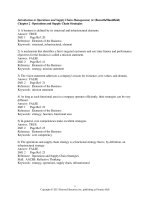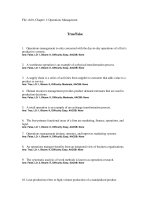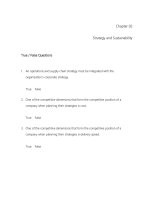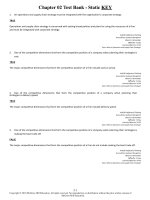Introduction to operations and supply chain management 3e bozarth chapter 08
Bạn đang xem bản rút gọn của tài liệu. Xem và tải ngay bản đầy đủ của tài liệu tại đây (566.36 KB, 41 trang )
Logistics
Chapter 8
Chapter Objectives
Be able to:
Describe why logistics is important and discuss the major decision areas that
make up logistics.
List the strengths and weaknesses of the various modes of transportation and
discuss the role of multimodal solutions.
Identify the major types of warehousing solutions and their benefits.
Discuss the purpose of a logistics strategy and give examples of how logistics
can support the overall business strategy.
Calculate the percentage of perfect orders.
Calculate landed costs.
Explain what reverse logistics systems are, and describe some of the unique
challenges they create for firms.
Use the weighted center of gravity method to identify a potential location for
a business.
Develop and then solve, using Microsoft Excel’s Solver function, an assignment
problem.
Copyright © 2013 Pearson Education, Inc. publishing as Prentice Hall
8-2
Logistics Management
Logistics management – That part of supply chain
management that plans, implements, and controls
the efficient, effective forward and reverse flow and
storage of goods, services, and related information
between the point of origin and the point of
consumption in order to meet customers’
requirements.
© CSCMP – Council of Supply Chain Management Professionals
Copyright © 2013 Pearson Education, Inc. publishing as Prentice Hall
8-3
Logistics Management
Transportation
Warehousing
Material handling
Packaging
Inventory management
Logistics information systems
Copyright © 2013 Pearson Education, Inc. publishing as Prentice Hall
8-4
Why Logistics Is Critical
Impact on cost, flexibility, and delivery performance
Advances in information systems
Globalization of markets
Push toward sustainability
Copyright © 2013 Pearson Education, Inc. publishing as Prentice Hall
8-5
Transportation
Highway
Water
Air
Rail
Pipeline
Copyright © 2013 Pearson Education, Inc. publishing as Prentice Hall
8-6
Comparison of Modes
from 1997-2007
Table 8.1
Copyright © 2013 Pearson Education, Inc. publishing as Prentice Hall
8-7
Highway
Dominates the logistics infrastructure due to:
Geographic extension of supply chains
Greater emphasis on delivery speed and flexibility
Has become more cost effective over time due to:
Better scheduling and use of vehicle capacity
More efficient and reliable vehicles
Increased cost competition due to deregulation
Involves different types of shipments
Direct truck – Shipment made with no stops
Less than truckload (LTL) – Smaller shipment combined with
other loads
Copyright © 2013 Pearson Education, Inc. publishing as Prentice Hall
8-8
Water
Ideal for materials with high weight-to-value ratio,
especially if delivery speed is not critical.
Examples: farm produce, timber, petroleum-based
products.
Copyright © 2013 Pearson Education, Inc. publishing as Prentice Hall
8-9
Air
Ideal for customers with a low weight-to-value ratio,
especially if delivery speed or delivery reliability is
critical.
Higher shipping costs and improvement in other
modes have reversed the rise in air growth over the
past decade.
Copyright © 2013 Pearson Education, Inc. publishing as Prentice Hall
8 - 10
Rail
Characteristics similar to Water but more flexible.
To accommodate growth, rail carriers have doubled
the number of lines along busy corridors, changed
the physical configuration of the trains, and utilized
multimodal solutions.
Copyright © 2013 Pearson Education, Inc. publishing as Prentice Hall
8 - 11
Selecting a Transportation Mode
Table 8.2
Copyright © 2013 Pearson Education, Inc. publishing as Prentice Hall
8 - 12
Multimodal Solutions
Multimodal solution – A transportation solution
that seeks to exploit the strengths of multiple
transportation modes through physical,
information, and monetary flows that are as
seamless as possible
Roadrailer – A specialized rail car the size of a standard
truck trailer that can be quickly switched from rail to
ground transportation without changing the wheels.
Copyright © 2013 Pearson Education, Inc. publishing as Prentice Hall
8 - 13
Warehousing
Warehousing – Any operations that stores,
repackages, stages, sorts, or centralizes goods or
materials.
Warehousing can be used to:
Reduce transportation costs
Improve operational flexibility
Shorten customer lead times
Lower inventory-related costs.
Copyright © 2013 Pearson Education, Inc. publishing as Prentice Hall
8 - 14
Consolidation Warehousing
Consolidation warehousing – A form of
warehousing that pulls together shipments from a
number of sources in the same geographic area and
combines them into larger and more economical
loads
Cross-docking
Break-bulk
Hub-and-spoke system
Copyright © 2013 Pearson Education, Inc. publishing as Prentice Hall
8 - 15
Consolidation Warehousing
Figure 8.2
Copyright © 2013 Pearson Education, Inc. publishing as Prentice Hall
8 - 16
Cross-Docking
Figure 8.3
Copyright © 2013 Pearson Education, Inc. publishing as Prentice Hall
8 - 17
Hub-and-Spoke System
Figure 8.5
Copyright © 2013 Pearson Education, Inc. publishing as Prentice Hall
8 - 18
Postponement Warehousing
Postponement warehousing – A form of
warehousing that combines classic warehouse
operations with light manufacturing and packaging
duties to allow firms to put off final assembly or
packaging of goods until the last possible moment.
Copyright © 2013 Pearson Education, Inc. publishing as Prentice Hall
8 - 19
Types of Warehouses
Assortment warehouses – A form of warehouses in
which a wide array of goods is held close to the
source of demand in order to assure short customer
lead times.
Spot stock warehouses – A form of warehouses that
attempts to position seasonal goods close to the
marketplace.
Copyright © 2013 Pearson Education, Inc. publishing as Prentice Hall
8 - 20
Logistics Information Systems
Decision support tools
Real-time simulation and optimization
Cost estimations
Planning systems
Carrier selection
Scheduling deliveries
Execution systems
RFID
Copyright © 2013 Pearson Education, Inc. publishing as Prentice Hall
8 - 21
Material Handling and Packaging
Material handling system – A system that includes
the equipment and procedures needed to move
goods within a facility, between a facility and a
transportation mode, and between different
transportation modes.
Packaging – The way goods and materials are
packed in order to facilitate physical, informational,
and monetary flows through the supply chain.
Copyright © 2013 Pearson Education, Inc. publishing as Prentice Hall
8 - 22
Inventory Management
Implications for transportation:
Using slower and cheaper transportation modes will cause
inventory levels within the supply chain to rise.
Using faster and more expensive transportation modes will
enable firms to lower inventory levels.
Implication for warehousing:
Warehousing and inventory managers must work closely to
achieve the desired business outcome.
Copyright © 2013 Pearson Education, Inc. publishing as Prentice Hall
8 - 23
Logistics Strategy
Logistics strategy – A functional strategy which
ensures that an organization’s logistics choices are
consistent with its overall business strategy and
support the performance dimensions that targeted
customers most value.
Copyright © 2013 Pearson Education, Inc. publishing as Prentice Hall
8 - 24
Owning vs. Outsourcing
Does the firm have the volume needed to justify a
private logistics system?
Would owning a logistics system limit the firm’s
ability to respond to changes in the marketplace or
supply chain?
Is logistics a core competency for the firm?
Outsourcing options:
• Common carriers
• Contract carriers
• Third-party logistics providers (3PL)
Copyright © 2013 Pearson Education, Inc. publishing as Prentice Hall
8 - 25









